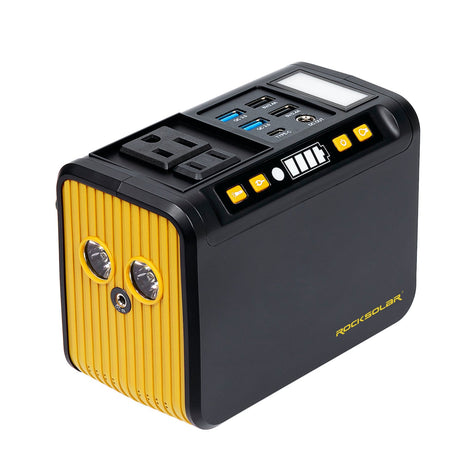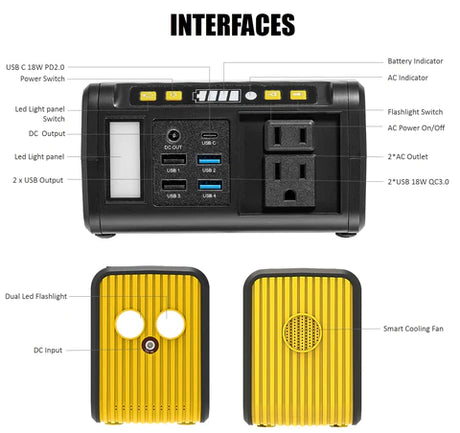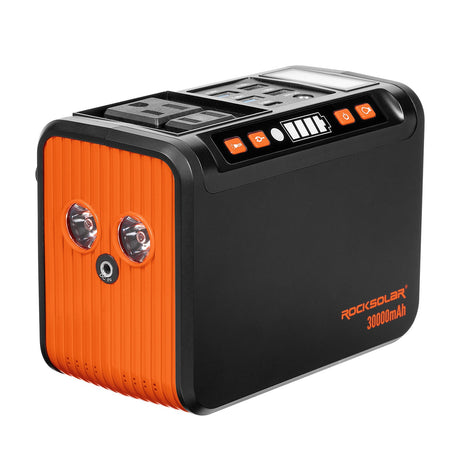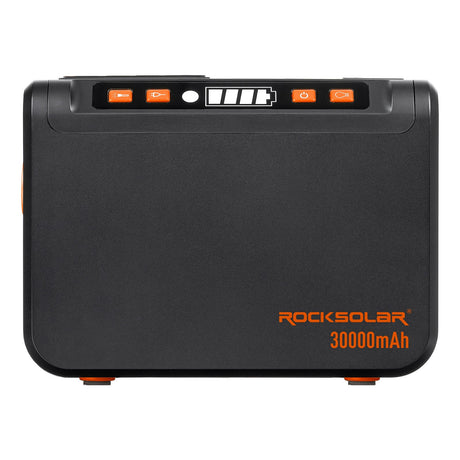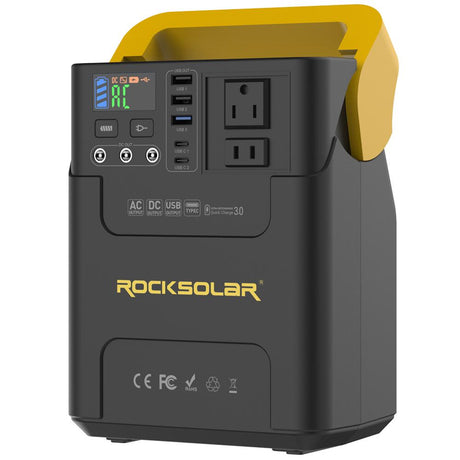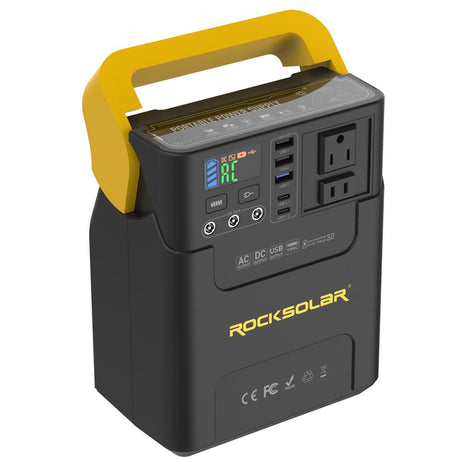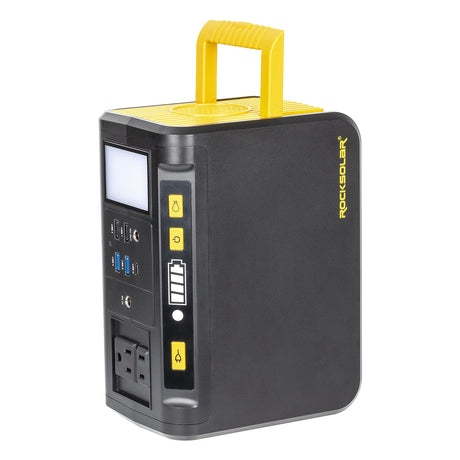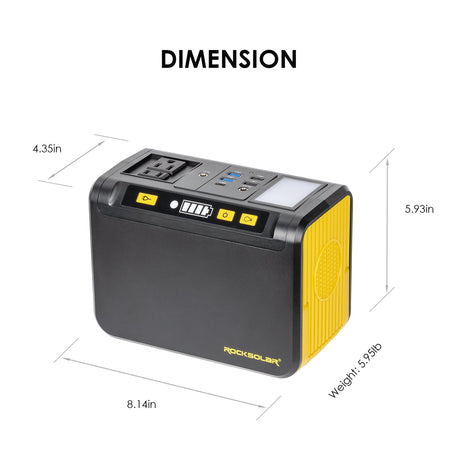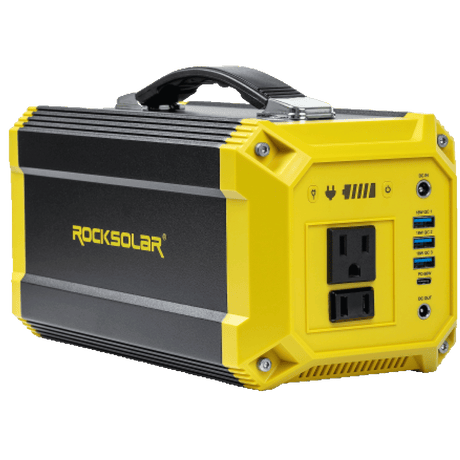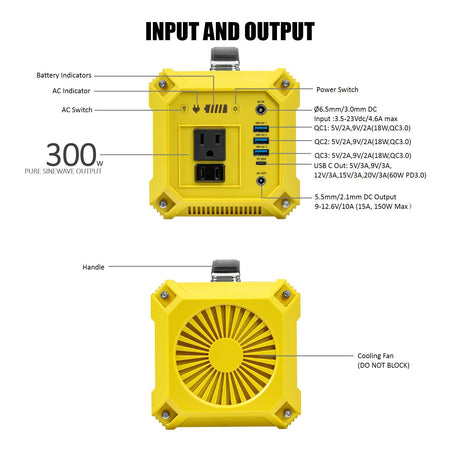FAQs
Portable Power Stations
What is a portable power station?
What is a portable power station?
A portable power station is a rechargeable battery-powered generator. ROCKSOLAR portable power stations are compact, lightweight, and designed to provide electricity that's reliable and convenient to carry around.
How long does it take to fully charge a ROCKSOLAR portable power station?
How long does it take to fully charge a ROCKSOLAR portable power station?
The charging time for a ROCKSOLAR power station can vary depending on the model and the power source. Typically, it can take between 5 to 7 hours when using an AC wall outlet.
How should I store my ROCKSOLAR portable power station when not in use?
How should I store my ROCKSOLAR portable power station when not in use?
For best results, store your power station in a cool, dry place and recharge it every three months to help maintain battery health.
What devices can I power with my ROCKSOLAR portable power station?
What devices can I power with my ROCKSOLAR portable power station?
ROCKSOLAR power stations can power a range of devices like smartphones, tablets, laptops, cameras, lights, and even some appliances. However, the capacity to power depends on the model of the power station and the power requirements of the device.
Does my ROCKSOLAR portable power station come with a warranty?
Does my ROCKSOLAR portable power station come with a warranty?
Yes, all ROCKSOLAR portable power stations come with a 1-year warranty that covers defects in materials and workmanship under normal use.
Can I charge my ROCKSOLAR portable power station using solar power?
Can I charge my ROCKSOLAR portable power station using solar power?
Yes, ROCKSOLAR power stations can be charged using compatible solar panels. The charging time will depend on the strength of sunlight and the wattage of the solar panel.
Solar Panels
Can solar panels be used in home backup systems?
Can solar panels be used in home backup systems?
Yes, solar panels can be integrated into home backup systems. They work seamlessly with battery storage solutions to store excess energy generated during the day, which can then be used during power outages or at night to ensure uninterrupted electricity supply
What is the lifespan of solar panels?
What is the lifespan of solar panels?
Solar panels are designed to last a long time, often with a lifespan of 25-30 years. Most manufacturers offer warranties of 10-12 years for product defects and 25 years for performance, ensuring that the panels will still produce around 80-90% of their initial capacity at the end of the warranty period.
Are solar panels suitable for off-grid applications?
Are solar panels suitable for off-grid applications?
Yes, solar panels are an excellent solution for off-grid applications. They are commonly used in remote locations, RVs, cabins, and boats where grid electricity is unavailable. Pairing solar panels with batteries allows for energy storage and reliable power even during periods without sunlight.
Solar Water Pump
Is it profitable to install a solar pumping system?
Is it profitable to install a solar pumping system?
Yes, installing a solar pumping system can be profitable, especially in areas with abundant sunlight. Solar pumps have low operating costs since they utilize free solar energy, reducing or eliminating electricity or fuel expenses. Over time, the initial investment can be offset by these savings, making solar pumping systems a cost-effective solution.
How can I apply for government grants or subsidies for solar water pumps?
How can I apply for government grants or subsidies for solar water pumps?
Visit your local, provincial, or federal government websites to confirm if you're eligible—typically, farmers, agricultural landowners, and rural users qualify.
How long do solar pump systems last?
How long do solar pump systems last?
Solar pump systems are designed for durability and longevity. With proper maintenance, the photovoltaic panels can last 25 years or more, while the pumps themselves typically have a lifespan of 10 to 15 years. Regular maintenance ensures optimal performance and extends the system's operational life.
Which is better—a DC or an AC pump?
Which is better—a DC or an AC pump?
The choice between a DC (Direct Current) and an AC (Alternating Current) pump depends on the specific application and system requirements. DC pumps are often more efficient and better suited for small to medium-scale applications, such as livestock watering, small irrigation systems, or garden fountains, as they can be directly connected to solar panels without needing an inverter, reducing system complexity and cost.
Off Grid Solar Kits
Do I need solar panels for an off-grid system?
Do I need solar panels for an off-grid system?
While solar panels are a common and sustainable energy source for off-grid systems, they are not the only option. Alternative energy sources such as wind turbines, micro-hydro systems, or generators can also be utilized, depending on the location and available resources.
What is the most cost-effective way to power my remote cabin?
What is the most cost-effective way to power my remote cabin?
The most cost-effective power solution for a remote cabin depends on factors like location, energy needs, and available natural resources. A small-scale off-grid solar system is often an economical choice, especially in sunny areas. In regions with consistent wind, a wind turbine might be more suitable.
Can I expand my off-grid system later?
Can I expand my off-grid system later?
Yes, many off-grid systems are designed to be scalable. You can add more solar panels, batteries, or other components to increase capacity as your energy needs grow. However, it's essential to plan for expansion during the initial design to ensure compatibility and avoid potential issues.
Lifepo4 Battery
What is a LiFePO4 battery?
What is a LiFePO4 battery?
A LiFePO4 battery, or lithium iron phosphate battery, is a type of lithium-ion battery that uses lithium iron phosphate as its cathode material. Known for their high energy density, long lifespan, and enhanced safety features, LiFePO4 batteries are commonly used in applications such as electric vehicles, solar energy systems, and portable electronics.
Is LiFePO4 better than other lithium-ion batteries?
Is LiFePO4 better than other lithium-ion batteries?
LiFePO4 batteries offer several advantages over other lithium-ion chemistries, including enhanced safety due to their thermal and chemical stability, longer cycle life, and the use of non-toxic materials. While they have a slightly lower energy density compared to some other lithium-ion batteries, their durability and safety make them a preferred choice for many applications.
How many years do LiFePO4 batteries last?
How many years do LiFePO4 batteries last?
LiFePO4 batteries are known for their long lifespan, often lasting up to 10 years or more with proper care. They can endure between 2,500 to over 9,000 charge cycles, depending on usage patterns and environmental conditions.
Are LiFePO4 batteries safe?
Are LiFePO4 batteries safe?
Yes, LiFePO4 batteries are considered safe due to their stable chemical composition. They are less prone to overheating and thermal runaway compared to other lithium-ion chemistries. Additionally, they are non-toxic and environmentally friendly, containing no rare earth metals.
Grid Tie Inverters
How does a grid-tie inverter work?
How does a grid-tie inverter work?
Grid-tie inverters continuously monitor the voltage and frequency of the utility grid and adjust their output to match it precisely. They convert the DC power from solar panels into AC power that aligns in phase and frequency with the grid, enabling seamless integration .
Can I expand my grid-tie solar system in the future?
Can I expand my grid-tie solar system in the future?
Yes, grid-tie solar systems can be expanded by adding more solar panels and, if necessary, upgrading the inverter to handle the increased capacity. It's essential to consult with a solar professional to ensure compatibility and compliance with local regulations.
Do grid-tie inverters require maintenance?
Do grid-tie inverters require maintenance?
Grid-tie inverters are generally low-maintenance devices. However, it's recommended to have periodic inspections to ensure optimal performance and longevity.
Solar Wind Generators
What is wind energy, and how do wind turbines work?
What is wind energy, and how do wind turbines work?
Wind energy is the kinetic energy created by moving air. Wind turbines harness this energy by capturing the wind’s force with their blades. As the blades spin, they drive a generator that converts the rotational energy into electricity. Modern wind turbines use aerodynamic blade design and advanced control systems to maximize power output while maintaining safe and efficient operations.
How do I properly site a wind turbine for my home?
How do I properly site a wind turbine for my home?
Proper siting involves evaluating wind speed, wind direction, local regulations, and obstacles such as buildings or trees. Typically, home-based wind turbines should be placed on open land or on a tower tall enough to capture strong, consistent winds. An optimal location will have minimal turbulence and obstructions. It’s also advisable to consult professionals for wind resource assessments, zoning permissions, and compliance with local building codes.
How much maintenance does a wind turbine require?
How much maintenance does a wind turbine require?
Maintenance needs can vary based on factors such as turbine model, environmental conditions, and operational hours. Generally, turbines require routine inspections and maintenance at least twice a year. Scheduled maintenance often includes checking and replacing lubricants, inspecting rotor blades and electrical components, and ensuring that safety systems function correctly.
Off Grid Inverters
What is an Off-Grid Solar Inverter?
What is an Off-Grid Solar Inverter?
An off-grid solar inverter is a device that converts the DC power generated by solar panels into AC power for home or commercial use.
How does an Off-Grid Solar Inverter work?
How does an Off-Grid Solar Inverter work?
The inverter takes DC electricity from solar panels or batteries and converts it into usable AC electricity. During the day, solar energy powers appliances and charges the battery. At night or during cloudy weather, the inverter draws energy from the battery to keep the system running.
Can I use an Off-Grid Solar Inverter without batteries?
Can I use an Off-Grid Solar Inverter without batteries?
No, off-grid solar inverters require batteries to store energy since they operate independently from the utility grid. The batteries ensure continuous power supply during the night or when solar generation is low.
How long does an Off-Grid Solar Inverter last?
How long does an Off-Grid Solar Inverter last?
A high-quality off-grid inverter typically lasts 10–15 years with proper maintenance. Regular cleaning, proper ventilation, and avoiding overload can extend its lifespan.
Shipping
What countries do you ship to?
What countries do you ship to?
We currently ship to the United States, Canada, Australia and the UK. To enquire about shipping to a different destination, please contact us.
How long will it take to receive my order?
How long will it take to receive my order?
Standard shipping normally takes 3-5 days. Next day shipping is available on all domestic orders (for an additional charge). International shipping times depend on the products and destination (estimated at checkout).
Returns and Refunds
How do I return a product?
How do I return a product?
Items must be returned within 30 days after receiving your order. Items must be returned in the same condition in which they were received, be unworn/unused, have any tags still attached, and include all the original packaging.
How long will it take to receive my refund?
How long will it take to receive my refund?
Refunds are processed within 7 days from when we receive the item(s).

